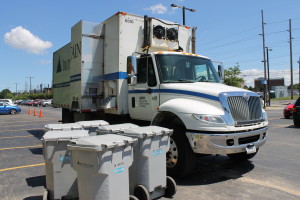 For the third year in a row, University of Rochester employees took advantage of the Shred Fest, the annual secure document shredding event sponsored by University Facilities and Services. On Friday July 26, a steady stream of people came into Park Lot to drop off their assorted personal documents, ranging from bank statements and medical records, to tax returns and more.
For the third year in a row, University of Rochester employees took advantage of the Shred Fest, the annual secure document shredding event sponsored by University Facilities and Services. On Friday July 26, a steady stream of people came into Park Lot to drop off their assorted personal documents, ranging from bank statements and medical records, to tax returns and more.
Participants showed their appreciation and dedication to the program, and many shared the plans they made in advance to ensure they would be ready for this years’ event. One participant told us that she and her husband hired a babysitter in order to thoroughly collect their household documents, and another woman took a vacation day to clean out her house and organize her documents to be securely shredded. We value your participation and hope to see you again next year!
Why is the event so popular? Many people feel that their privacy is more protected when documents are thrown in the trash rather than placed in an open curb-side recycling bin. But unfortunately, identity thieves are known to steal papers right out of trash cans. Furthermore, paper recycling avoids using new trees to make paper, saves space in landfills, and avoids the impact of obtaining, transporting, and milling fresh lumber. When desk-top shredders don’t hold up to our needs, we are left with piles of paper that can stack up fast. But the Shred Fest offers a convenient way to keep your information secure while being environmentally friendly. Volunteers stand by to help unload the boxes, bags, and bins of paper out of vehicles. Documents are placed in locked containers and shredded on-site in Iron Mountain‘s mobile shred truck in order to prevent documents from falling into the wrong hands. All of the shredded paper is then recycled.
 This year, 114 containers were filled with paper documents accounting for approximately 23,950 pounds. That’s over 11 tons of paper! From this event, 192 trees were prevented from harvesting and 33.6 cubic yards of landfill space will not be used. This is a huge increase over the last two years – 15,750 pounds (75 containers) in 2012 and 12,390 pounds (59 containers) in 2011. The final results of this year marks a substantial improvement over last year’s by a difference of 39 containers and three tons.
This year, 114 containers were filled with paper documents accounting for approximately 23,950 pounds. That’s over 11 tons of paper! From this event, 192 trees were prevented from harvesting and 33.6 cubic yards of landfill space will not be used. This is a huge increase over the last two years – 15,750 pounds (75 containers) in 2012 and 12,390 pounds (59 containers) in 2011. The final results of this year marks a substantial improvement over last year’s by a difference of 39 containers and three tons.
Due to this year’s overwhelming demand, plans are being made to maximize efficiency at next year’s event and better accommodate the growing number of participants. It is because of the overwhelming popularity and success of the Shred Fest that we have received from the University of Rochester community that we are able to continue the event. Thank you to all our volunteers, workers, shred truck operators, Iron Mountain for their partership, and especially those of you who participated to make our event successful.
To see more pictures of the Third Annual Shred Fest, take a look at UR Sustainable’s Facebook page.
By Alanna Scheinerman, Class of 2013



thanks
Great article. Privacy is especially important in hospitals where patient information is often carried by doctors in paper lists that need to be carefully shredded.
What exactly is a “tree equivalent”?
If you go to iron mountain’s website and poke around on their corporate responsibility page, like I did, you should be able to find where it looks like they came up with those numbers. It’s a blog post by an organization called conservatree (This is where the calculations to get those final numbers on the green reprort card come from, or so it seems). Its not the case that however many trees were saved, it’s a very ballpark number with many assumptions going into it. That really should be appropriately noted in these posts. I looked but wasn’t able to find a source for the landfill space claim.
Iron Mountain has its own metrics that we use. Based on their report to us,16 tree equivalents are saved from one ton of recycled paper. The total tons of the shred fest were 11.98, therefore 192 tree equivalents were saved. Similarly, 2.8 cubic yard of landfill space is equivalently saved from 2.8 tons pounds of paper. Therefore 33.6 cubic yards are saved from 11.98 tons. Also it’s not that both 192 trees and 33.6 of space were saved, it’s one or the other. Sorry if that was not clear.
Alanna
Hi,
Can you please show how you calculated that 192 trees were saved from harvesting and 33.6 cubic yards of landfill space were not used? Thank you.